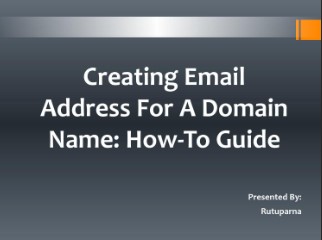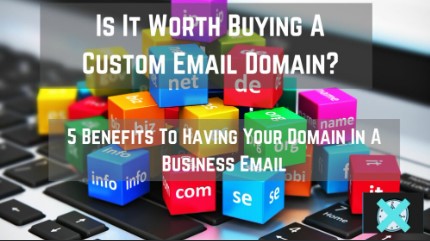Get Domain With Email
In the vast expanse of the digital universe, your domain name serves as your unique identifier, your personal or business fingerprint. It’s the cornerstone of your online presence, providing a foundation upon which your brand’s digital identity is built.
A memorable domain name not only helps visitors find you more easily but also establishes a sense of credibility and professionalism. Just as a physical storefront signals a legitimate business, a customized domain asserts your serious commitment to the online realm.
Building Brand Credibility: Why Your Domain Name Matters
A bespoke domain name is more than a URL; it’s a branding tool that conveys trustworthiness and authenticity. Consumers are more likely to engage with and purchase from a site that has a professional, custom domain rather than a generic, free alternative.
A well-chosen domain name reflects your brand’s mission and vision, making a lasting impression. It helps distinguish you from competitors, reinforces brand identity, and builds customer loyalty. In essence, your domain name is an integral part of your brand’s narrative.
The Impact on SEO: Boosting Your Visibility
Search engine optimization (SEO) is crucial for online visibility, and your domain name plays a significant role. Search engines favor websites with relevant, keyword-rich domains, pushing them higher in search results.
A well-thought-out domain name can enhance your SEO efforts, making it easier for potential customers to find you. Moreover, a domain with your brand name or main product/service keyword can improve click-through rates and reduce bounce rates, further boosting your site’s performance on search engines.
Protection from Cybersquatting: Securing Your Brand’s Future
Cybersquatting, the practice of registering domains resembling well-known brands to profit from their traffic, is a serious threat. By securing your domain early, you protect your brand from potential misuse.
A proactive approach ensures that your domain remains an exclusive asset of your brand, safeguarding your reputation and digital integrity. Owning your domain not only prevents others from exploiting your brand but also ensures that your customers always find you and not an impostor.
Understanding Domain and Email Hosting: The Basics
What is a Domain Name? Breaking Down the Essentials
A domain name is your website’s address on the internet. It’s the string of characters people type into their browser to visit your site, like “yourbusiness.com”.
It consists of two main parts: the name (which is unique to you) and the extension (such as .com, .org, .net). The right domain name is easy to remember, aligns with your brand, and enhances your professional image.
Email Hosting Explained: Beyond Free Email Services
Email hosting involves renting space on a server to manage your email services. Unlike free email services, professional email hosting provides custom email addresses (e.g., name@yourbusiness.com), which reinforce brand consistency and credibility.
Email hosting offers enhanced security, more storage, and better support, ensuring your business communications are smooth and secure.
The Synergy of Combining Domain and Email Hosting
Combining domain and email hosting under one roof simplifies management and creates a cohesive brand identity. It’s akin to having a unified office space where every aspect of your digital operations is seamlessly integrated.
This synergy ensures better security, streamlined support, and a more professional image. Plus, managing everything through a single provider often results in cost savings and simplified billing.
Choosing the Right Domain Name: Tips for Success
Brainstorming Your Perfect Domain: Creativity Meets Strategy
Choosing the right domain name requires a blend of creativity and strategy. Start by brainstorming keywords related to your business or industry.
Consider your brand’s unique selling points and how you want to be perceived. Play with different combinations and extensions. Tools like domain name generators can spark inspiration and help you find available names that match your vision.
Keeping it Short and Memorable: The Art of Simplification
Simplicity is key. A short, easy-to-remember domain name is more likely to stick in people’s minds. Avoid complex spellings and long strings of words.
Think of iconic brands like Google, Apple, or Amazon – their domains are succinct and easy to recall. The easier your domain is to remember and type, the more likely visitors will find and return to your site.
Considering Keywords and Branding: A Balanced Approach
Incorporating relevant keywords into your domain can boost your SEO, but don’t overdo it. Your domain should be a balance of keyword relevance and brand identity.
For example, if you’re a bakery, a domain like “DeliciousBakes.com” combines a keyword with a branding element. This approach ensures your domain is both search-friendly and unique to your brand.
Avoiding Common Pitfalls: What Not to Do
Steer clear of trends that might fade, avoid numbers and hyphens that can confuse users, and ensure your domain doesn’t infringe on existing trademarks.
Conduct thorough research to avoid legal issues and future rebranding headaches. Ensure your domain is easy to pronounce and spell, and avoid using slang or jargon that might alienate parts of your audience.
The Process of Getting a Domain with Email: Step-by-Step Guide
Researching and Selecting a Reputable Registrar
Begin by researching domain registrars, the companies that manage the reservation of domain names. Look for registrars with good reputations, transparent pricing, and robust support services.
Read reviews and compare features to find a registrar that fits your needs and budget. Trustworthy registrars often provide additional services such as privacy protection and auto-renewal.
Comparing Packages: Features, Pricing, and Extras
Domain registrars and email hosting providers offer various packages. Compare these based on features like storage space, security options, and customer support. Consider the total cost, including any renewal fees, and look for packages that offer bonuses such as free SSL certificates or website builders. Ensure you understand what’s included and whether it meets your business’s current and future needs.
Registering Your Domain: A Walkthrough
Once you’ve chosen a registrar, search for your desired domain to check its availability. If it’s available, proceed with the registration process. Fill in the required details, including your contact information, and choose your desired registration term (typically one year, with options to renew). Complete the purchase and follow the instructions to verify your ownership.
Setting Up Professional Email: Configuration and Customization
After registering your domain, set up your email hosting. Configure your email accounts through the hosting provider’s dashboard, creating custom email addresses that match your domain.
Customize your email settings, including spam filters, forwarding options, and signature templates. Sync your email with devices and email clients to ensure seamless communication.
Top Providers for Domain and Email Services: A Comparative Look
GoDaddy: Comprehensive Solutions for Beginners and Pros
GoDaddy offers a wide range of services, from domain registration to email hosting and website building. Its user-friendly interface and comprehensive customer support make it a popular choice for both beginners and experienced users. GoDaddy provides robust security features and various pricing plans to suit different needs.
Namecheap: Affordable and User-Friendly Options
Namecheap is known for its competitive pricing and straightforward interface. It offers a variety of domain extensions and email hosting packages, making it an excellent choice for budget-conscious users. Namecheap also provides free domain privacy protection and reliable customer service.
Google Workspace: Seamless Integration with Google Services
Google Workspace combines domain and email hosting with a suite of productivity tools. Its seamless integration with Google’s ecosystem makes it ideal for businesses already using Gmail, Google Drive, and other Google services. Google Workspace offers enhanced security, ample storage, and collaboration features.
Microsoft 365: Power-Packed Tools for Businesses
Microsoft 365 provides domain and email hosting along with access to Microsoft’s suite of productivity tools, including Word, Excel, and Teams.
It’s designed for businesses looking for robust tools to enhance productivity and collaboration. Microsoft 365 offers advanced security features, large storage capacities, and excellent customer support.
Managing Your Domain and Email: Best Practices
Regular Renewals: Keeping Your Domain Active
Ensure your domain doesn’t expire by setting up automatic renewals with your registrar. Regular renewals keep your domain active and prevent it from being taken by someone else. Monitor your renewal dates and maintain accurate contact information to avoid lapses in service.
Email Management Tips: Organizing and Optimizing Your Inbox
Efficient email management is crucial for productivity. Use folders and labels to organize your inbox, set up filters to sort incoming emails, and regularly clean out unnecessary messages. Utilize tools like auto-responders and email scheduling to streamline communication.
Securing Your Accounts: Implementing Strong Passwords and 2FA
Security is paramount. Use strong, unique passwords for your domain and email accounts. Enable two-factor authentication (2FA) to add an extra layer of protection. Regularly update your passwords and be vigilant about phishing scams and other online threats.
Scaling Up: Adding More Domains and Email Addresses as You Grow
As your business grows, you may need additional domains or email addresses. Most providers allow you to easily add new domains and configure additional email accounts. This scalability ensures your digital infrastructure can grow alongside your business needs.
Troubleshooting Common Issues: Quick Fixes and Support
Email Deliverability Problems: Causes and Solutions
Issues with email deliverability can disrupt communication. Common causes include spam filters, incorrect DNS settings, or blacklisting. Use email authentication methods like SPF, DKIM, and DMARC to improve deliverability. Regularly monitor your email server’s reputation and address any issues promptly.
DNS Configuration Errors: How to Resolve Them
DNS errors can lead to website and email downtime. Ensure your DNS settings are correctly configured and regularly update them as needed. Use your provider’s DNS management tools or seek support if you encounter issues.
Support Resources: Where to Find Help
When problems arise, knowing where to find help is crucial. Utilize your provider’s support resources, including live chat, email support, and knowledge bases. Community forums and online tutorials can also provide valuable assistance.
Maximizing the Benefits of Your Domain and Email Combo
Enhancing Communication: Professional Email Etiquette Tips
Professional email etiquette fosters clear and effective communication. Use clear subject lines, concise messages, and proper salutations. Proofread your emails for errors and be mindful of your tone. Good etiquette reflects positively on your brand and improves professional relationships.
Leveraging Email for Marketing: Strategies and Tools
Email marketing remains a powerful tool for engagement and conversion. Use targeted campaigns, personalization, and automation to reach your audience effectively. Tools like Mailchimp or Constant Contact can help manage and optimize your email marketing efforts.
Building a Strong Online Presence: Beyond the Basics
Your domain and email are just the beginning. Build a strong online presence with quality content, active social media engagement, and strategic SEO. Regularly update your website, interact with your audience, and use analytics to refine your approach.
Conclusion: Empowering Your Digital Presence with the Right Domain and Email
Investing in Your Future: The Long-Term Benefits
Investing in a professional domain and email setup is a step towards securing your brand’s future. It enhances your credibility, improves communication, and lays the foundation for growth. The benefits extend far beyond the initial setup, providing long-term value.
Taking Action: Next Steps to Get Started Today
Ready to enhance your digital presence? Start by researching domain registrars and email hosting providers, choose the best options for your needs, and take the plunge. Secure your domain, set up your email, and begin reaping the benefits of a cohesive online identity. The digital world awaits—take action and step into the future of your brand.





